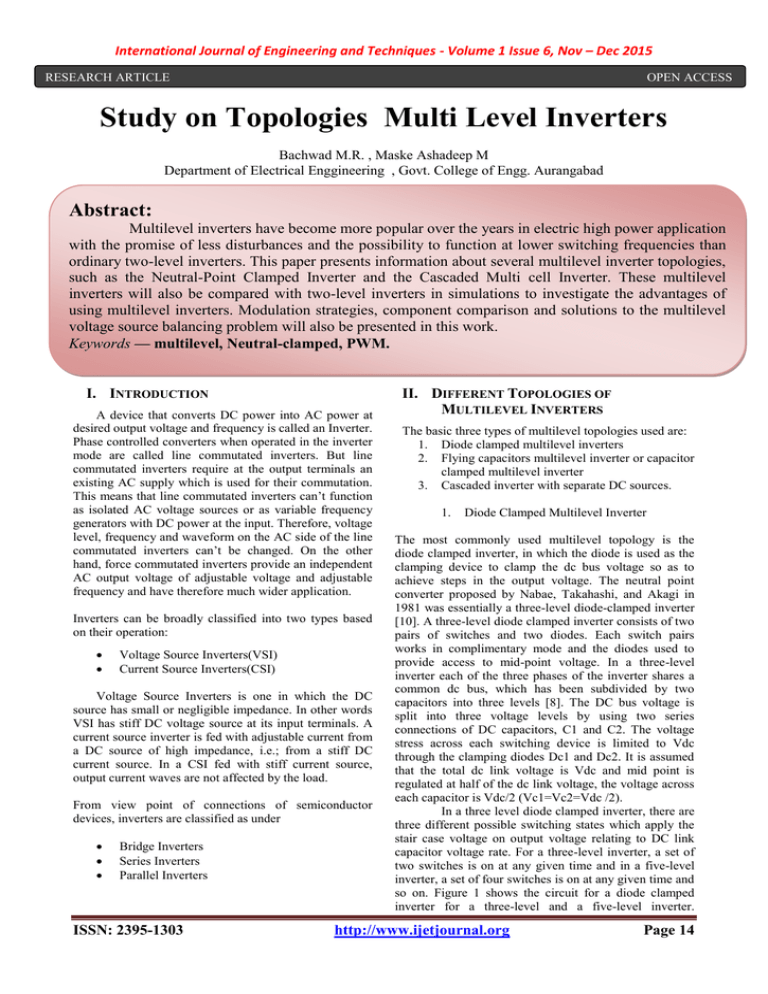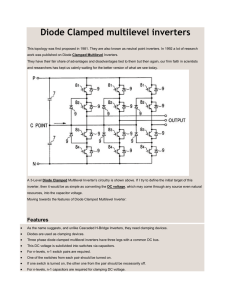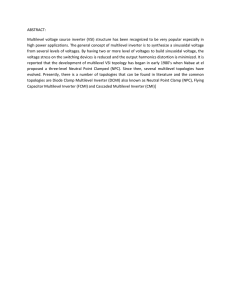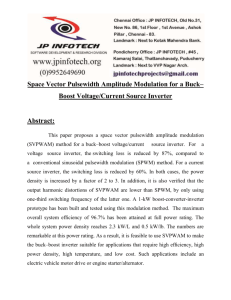
International Journal of Engineering and Techniques - Volume 1 Issue 6, Nov – Dec 2015
RESEARCH ARTICLE
OPEN ACCESS
Study on Topologies Multi Level Inverters
Bachwad M.R. , Maske Ashadeep M
Department of Electrical Enggineering , Govt. College of Engg. Aurangabad
.
Abstract:
Multilevel inverters have become more popular over the years in electric high power application
with the promise of less disturbances and the possibility to function at lower switching frequencies than
ordinary two-level inverters. This paper presents information about several multilevel inverter topologies,
such as the Neutral-Point Clamped Inverter and the Cascaded Multi cell Inverter. These multilevel
inverters will also be compared with two-level inverters in simulations to investigate the advantages of
using multilevel inverters. Modulation strategies, component comparison and solutions to the multilevel
voltage source balancing problem will also be presented in this work.
Keywords — multilevel, Neutral-clamped, PWM.
I. INTRODUCTION
A device that converts DC power into AC power at
desired output voltage and frequency is called an Inverter.
Phase controlled converters when operated in the inverter
mode are called line commutated inverters. But line
commutated inverters require at the output terminals an
existing AC supply which is used for their commutation.
This means that line commutated inverters can’t function
as isolated AC voltage sources or as variable frequency
generators with DC power at the input. Therefore, voltage
level, frequency and waveform on the AC side of the line
commutated inverters can’t be changed. On the other
hand, force commutated inverters provide an independent
AC output voltage of adjustable voltage and adjustable
frequency and have therefore much wider application.
Inverters can be broadly classified into two types based
on their operation:
Voltage Source Inverters(VSI)
Current Source Inverters(CSI)
Voltage Source Inverters is one in which the DC
source has small or negligible impedance. In other words
VSI has stiff DC voltage source at its input terminals. A
current source inverter is fed with adjustable current from
a DC source of high impedance, i.e.; from a stiff DC
current source. In a CSI fed with stiff current source,
output current waves are not affected by the load.
From view point of connections of semiconductor
devices, inverters are classified as under
Bridge Inverters
Series Inverters
Parallel Inverters
ISSN: 2395-1303
II. DIFFERENT TOPOLOGIES OF
MULTILEVEL INVERTERS
The basic three types of multilevel topologies used are:
1. Diode clamped multilevel inverters
2. Flying capacitors multilevel inverter or capacitor
clamped multilevel inverter
3. Cascaded inverter with separate DC sources.
1.
Diode Clamped Multilevel Inverter
The most commonly used multilevel topology is the
diode clamped inverter, in which the diode is used as the
clamping device to clamp the dc bus voltage so as to
achieve steps in the output voltage. The neutral point
converter proposed by Nabae, Takahashi, and Akagi in
1981 was essentially a three-level diode-clamped inverter
[10]. A three-level diode clamped inverter consists of two
pairs of switches and two diodes. Each switch pairs
works in complimentary mode and the diodes used to
provide access to mid-point voltage. In a three-level
inverter each of the three phases of the inverter shares a
common dc bus, which has been subdivided by two
capacitors into three levels [8]. The DC bus voltage is
split into three voltage levels by using two series
connections of DC capacitors, C1 and C2. The voltage
stress across each switching device is limited to Vdc
through the clamping diodes Dc1 and Dc2. It is assumed
that the total dc link voltage is Vdc and mid point is
regulated at half of the dc link voltage, the voltage across
each capacitor is Vdc/2 (Vc1=Vc2=Vdc /2).
In a three level diode clamped inverter, there are
three different possible switching states which apply the
stair case voltage on output voltage relating to DC link
capacitor voltage rate. For a three-level inverter, a set of
two switches is on at any given time and in a five-level
inverter, a set of four switches is on at any given time and
so on. Figure 1 shows the circuit for a diode clamped
inverter for a three-level and a five-level inverter.
http://www.ijetjournal.org
Page 14
International Journal of Engineering and Techniques - Volume 1 Issue 6, Nov – Dec 2015
Switching states of the three level inverter are
summarized in table 1
Table 1 Switching States in One Leg of the Three-Level Diode Clamped
Inverter
required. By increasing the number of voltage levels the
quality of the output voltage is improved and the voltage
waveform becomes closer to sinusoidal waveform.
However, capacitor voltage balancing will be the critical
issue in high level inverters. When N is sufficiently high,
the number of diodes and the number of switching
devices will increase and make the system impracticable
to implement. If the inverter runs under pulse width
modulation (PWM), the diode reverse recovery of these
clamping diodes becomes the major design challenge.
The structure is more complicated than the two-level
inverter; the operation is straight forward [11].
III.PULSE MODULATION SCHEMES
In PAM the successive sample values of the analog
signal s(t) are used to effect the amplitudes of a
corresponding sequence of pulses of constant duration
occurring at the sampling rate. No quantization of the
samples normally occurs (Fig. 1a, b). In principle the
pulses may occupy the entire time between samples, but
in most practical systems the pulse duration, known as
the duty cycle, is limited to a fraction of the sampling
interval. Such a restriction creates the possibility of
interleaving during one sample interval one or more
pulses derived from other PAM systems in a process
known as time-division multiplexing (TDM).
Figure 1 Topology of the Diode-Clamped Inverter (a) Three-Level
Inverter, (b) Five- Level Inverter.
Figure 2 shows the phase voltage and line voltage of
the three-level inverter in the balanced condition. The line
voltage Vab consists of a phase-leg a voltage and a
phase-leg b voltage. The resulting line voltage is a 5-level
staircase waveform for three-level inverter and 9- level
staircase waveform for a five-level inverter. This means
that an N-level diode-clamped inverter has an N-level
output phase voltage and a (2N-1)-level output line
voltage. In general the voltage across each capacitor for
an N level diode clamped inverter at steady state is V dc/
(N-1). Although each active switching device is required
to block only a voltage level of V dc, the clamping diodes
require different ratings for reverse voltage blocking [7].
Figure 3(a)Analog signal, s(t). (b) Pulse-amplitude modulation. (c)
Pulse-width modulation. (d) Pulse position modulation
Figure 2 Output Voltage in Three Level Diode Clamped Inverter (a)
Leg Voltage (b) Output Phase Voltage
In general for an N level diode clamped inverter,
for each leg 2(N-1) switching devices, (N-1) * (N-2)
clamping diodes and (N-1) dc link capacitors are
ISSN: 2395-1303
Pulse-width modulation
In PWM the pulses representing successive sample values
of s(t) have constant amplitudes but vary in time duration
in direct proportion to the sample value. The pulse
duration can be changed relative to fixed leading or
trailing time edges or a fixed pulse center. To allow for
http://www.ijetjournal.org
Page 15
International Journal of Engineering and Techniques - Volume 1 Issue 6, Nov – Dec 2015
time-division multiplexing, the maximum pulse duration
may be limited to a fraction of the time between samples.
Pulse-position modulation
PPM encodes the sample values of s (t) by varying the
position of a pulse of constant duration relative to its
nominal time of occurrence. As in PAM and PWM, the
duration of the pulses is typically a fraction of the
sampling interval. In addition, the maximum time
excursion of the pulses may be limited (Fig. 1d).
Pulse-code modulation
Many modern communication systems are designed to
transmit and receive only pulses of two distinct
amplitudes. In these so-called binary digital systems, the
analog-to-digital conversion process is extended by the
additional step of coding, in which the amplitude of each
pulse representing a quantized sample of s(t) is converted
into a unique sequence of one or more pulses with just
two possible amplitudes. The complete conversion
process is known as pulse-code modulation. Figure 2a
shows the example of three successive quantized samples
of an analog signal s(t), in which sampling occurs every T
seconds and the pulse representing the sample is limited
to T/2 seconds. Assuming that the number of quantization
levels is limited to 8, each level can be represented by a
unique sequence of three two-valued pulses
measurement of the amplitude, duration, or position of a
pulse in which these quantities are not constrained. Third,
the binary pulses propagating along a medium can be
intercepted and decoded at a point where the accumulated
distortion and attenuation are sufficiently low to assure
high detection accuracy. New pulses can then be
generated and transmitted to the next such decoding
point. This so-called process of repeatering significantly
reduces the propagation of distortion and leads to a
quality of transmission that is largely independent of
distance.
Why pulse width modulation?
Pulse-width modulation (PWM) of a signal or power
source involves the modulation of its duty cycle, to either
convey information over a communications channel or
control the amount of power sent to a load.
Advantages of PWM
Using pulse width modulation has several advantages
over analog control.
1.
2.
3.
4.
5.
The entire control circuit can be digital,
eliminating the need for digital-to-analog
converters.
Using digital control lines will reduce the
susceptibility of your circuit to interference. III.
Finally, motors may be able to operate at lower
speeds if you control them with PWM. When
you use an analog current to control a motor, it
will not produce significant torque at low
speeds.
The output voltage control can be obtained
without any additional components.
With this method, lower order harmonics can be
eliminated or minimized Along with its output
voltage control.
As higher order harmonics can be filtered easily
the higher order harmonics can be minimized.
IV.
Figure 4(a) Three successive quantized samples of an analog signal. (b)
With pulses of amplitude V or 0. (c) With pulses of amplitude V or –V
PCM enjoys many important advantages over
other forms of pulse modulation due to the fact that
information is represented by a two-state variable. First,
the design parameters of a PCM transmission system
depend critically on the bandwidth of the original signal
s(t) and the degree of fidelity required at the point of
reconstruction, but are otherwise largely independent of
the information content of s(t). This fact creates the
possibility of deploying generic transmission systems
suitable for many types of information. Second, the
detection of the state of a two-state variable in a noisy
environment is inherently simpler than the precise
ISSN: 2395-1303
APPLICATIONS
Dc power source utilization
Inverter designed to provide 115 VAC from the 12 VDC
source provided in an automobile. The unit provides up to
1.2 Amps of alternating current, or just enough to power
two sixty watt light bulbs.
An inverter converts the DC electricity from
sources such as batteries, solar panels, or fuel cells to AC
electricity. The electricity can be at any required voltage;
in particular it can operate AC equipment designed for
mains operation, or rectified to produce DC at any
desired voltage.
Grid tie inverters can feed energy back into the
distribution network because they produce alternating
current with the same wave shape and frequency as
supplied by the distribution system. They can also switch
http://www.ijetjournal.org
Page 16
International Journal of Engineering and Techniques - Volume 1 Issue 6, Nov – Dec 2015
off automatically in the event of a blackout.
Micro-inverters convert direct current from individual
solar panels into alternating current for the electric grid.
Uninterruptible power supplies
An uninterruptible power supply is a device which
supplies the stored electrical power to the load in case of
raw power cut-off or blackout. One type of UPS uses
batteries to store power and an inverter to supply AC
power from the batteries when main power is not
available. When main power is restored, a rectifier is used
to supply DC power to recharge the batteries.
It is widely used at domestic and commercial level in
countries facing Power outages.
V.
CONCLUSION
This paper provides a comprehensive study on multilevel
inverter topologies. Every topology has been described in
detail.
Today, more and more commercial products are
based on the multilevel inverter structure, and more and
more worldwide research and development of multilevel
inverter-related technologies is occurring.
REFERENCES
[1] P.S. Bhimbra, Power Electronics.
[2] M Rashid, Power Electronics.
Induction heating
Inverters convert low frequency main AC power to a
higher frequency for use in induction heating. To do this,
AC power is first rectified to provide DC power. The
inverter then changes the DC power to high frequency
AC power.
[3] Muhammad Ali Mazidi and Janice Gillispie Mazidi, “The 8051
Microcontroller and Embedded Systems, Pearson Prentice Hall
Publication”.
HVDC power transmission
With HVDC power transmission, AC power is rectified
and high voltage DC power is transmitted to another
location. At the receiving location, an inverter in a static
inverter plant converts the power back to AC.
[5] Atmel Corporation 2000, AT89C51 Microcontroller Datasheet.
Variable-frequency drives
A variable-frequency drive controls the operating speed
of an AC motor by controlling the frequency and voltage
of the power supplied to the motor. An inverter provides
the controlled power. In most cases, the variablefrequency drive includes a rectifier so that DC power for
the inverter can be provided from main AC power. Since
an inverter is the key component, variable-frequency
drives are sometimes called inverter drives or just
inverters.
Electric vehicle drives
Adjustable speed motor control inverters are currently
used to power the traction motor in some electric
locomotives and diesel-electric locomotives as well as
some battery electric vehicles and hybrid electric
highway vehicles such as the Toyota Prius. Various
improvements in inverter technology are being developed
specifically for electric vehicle applications.[2] In vehicles
with regenerative braking, the inverter also takes power
from the motor (now acting as a generator) and stores it
in the batteries.
[4] L Li, D Crazkowski, P Pillay, Y. Liu “Multileve l Selective
Harmonic Elimination PWM Technique in Series Connected Voltage
Inverters”, N Y USA.
[6] National Semiconductor, DAC 0808 (8 bit D/A Converter)
Datasheet.
[7]
A. Tahri, A. Draou and M. Ermis, “A Comparati ve Study of
PWM Control Techniques for Multilevel Cascaded Inverters,” Applied
Power Elect ronics Laboratory, Department of Electrotechnics,
University of Sciences and Technology of Oran, BP 1505 El Mnaouar
(31000 Oran), ALGERIA.
[8] N.A. Rahim (Member IEEE), E.A.Mahrous, K.M.Sor(Senior
Member IEEE), “Modeling And Simulation of Linear Generator PWM
Multilevel Inverter”, National Power and Energy Conference (PECon)
2003 Proceedings , Malaysia.
[9] Leon M Tolbert (Oak Ridge National Laboratory), Thomas
.G.Habetler (Georgia Institute of Technology, School of Electrical and
Computer Engineering, Atlanta),
“Novel Multilevel Inverter Carrier Based PWM Method ”.
[10] G. Sinha, T.A.Lipo, “A Four Level Rectifier In verter System
for Drive Applications” ,IEEE IAS Annual Meeting 1996, pp 980-987
[11] G.Carrara, D.Casini, S.Gardella, R.Salutari, “ Optimal PWM for
the Control of Multilevel Voltage Source Inverter” , Fifth Annual
European Co nference on Power Electronics , volume 4 ,1993 ,pp255259
The general case
A transformer allows AC power to be converted to any
desired voltage, but at the same frequency. Inverters, plus
rectifiers for DC, can be designed to convert from any
voltage, AC or DC, to any other voltage, also AC or DC,
at any desired frequency. The output power can never
exceed the input power, but efficiencies can be high, with
a small proportion of the power dissipated as waste heat.
ISSN: 2395-1303
http://www.ijetjournal.org
Page 17







